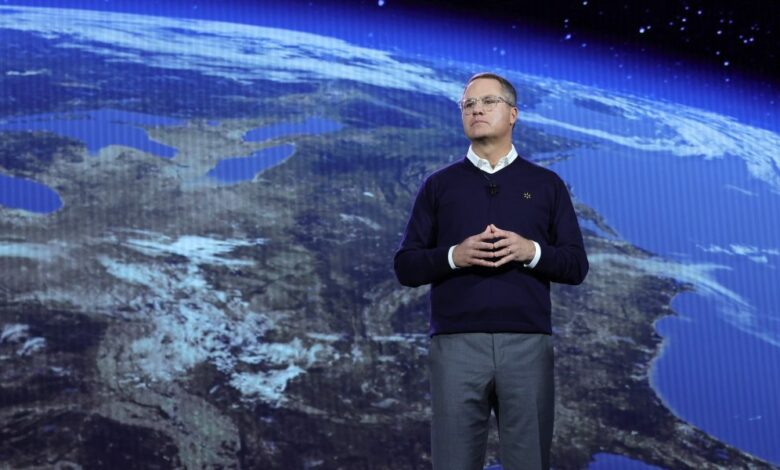Walmart hits ‘Project Gigaton’ goal 6 years early, cutting roughly a Japan’s worth of emissions from its supply chain


Walmart may not be the first corporation that comes to mind when you think of “green companies,” but maybe it should be. Back in 2017, before the SEC climate rule was even a twinkle in Gary Gensler’s eye, Walmart launched Project Gigaton, an ambitious project to eliminate one gigaton of greenhouse gas emissions from its supply chain by 2030. (For reference, that’s 1 billion metric tons—close to the amount Japan releases in one year as of 2021.)
During an earnings call in February, Walmart announced that Project Gigaton had met its goal—six years early. More than 5,900 suppliers, responsible for around 75% of Walmart’s sales, have participated.
Walmart partnered with organizations including the Environmental Defense Fund (EDF), a nonprofit advocacy group, to get Project Gigaton up and running. Fred Krupp, president of the EDF, spoke with CFO Brew about how Walmart was able to achieve the success that it did—and what other companies can learn from it.
Why Walmart?
The EDF first approached Walmart about reducing its emissions “about 20 years ago,” Krupp said, “in recognition of how powerful they could be as a leader for change.” At that time, “there hadn’t been so much attention” paid to the business case for ESG, he said, noting, “We saw it as a way to have this highly respected business leader make the point that things that are good for business could also be good for the environment.”
At first, according to Krupp, Walmart executives weren’t receptive, but, over time, attitudes changed. As upwards of 90% of retailers’ emissions are from sources outside a company’s direct control (like its supply chain), according to the National Retail Federation, suppliers were a natural place to focus. “To the extent [Walmart] could have an impact on their 100,000 suppliers, that could change the world,” Krupp said.
Initially, the company set a goal to have its suppliers prevent 20 million metric tons of emissions from being released, Krupp said. After achieving that goal, it set its sights 50 times bigger: one gigaton.
How Project Gigaton works
Walmart encourages its suppliers to take steps to reduce their emissions in one or more of six areas: nature; energy use; product design and usage; packaging; transport; and waste.
Supplier data “goes through an intensive QAQC [quality assurance and quality control] process that includes checks that identify outliers and duplication,” Aman Singh, Walmart’s director of global responsibility communications for sustainability, told CFO Brew in an email. If data exceeds certain thresholds, Walmart will reach out to suppliers for supporting documentation.
“A team of experts reviews select submissions and signs off on the final data,” Singh said.
Suppliers that meet the criteria are recognized on Walmart’s website. In FY 2023, more than 750 suppliers earned “Sparking Change” status, and more than 1,100 received “Giga Guru” status, Singh said.
As Walmart has suppliers ranging in size from giants like Procter and Gamble down to small companies making just a handful of products, it provides a range of ways for them to participate. Smaller or less-experienced suppliers can concentrate on just one of the six areas; those that are better-versed in ESG can tackle more.
“Our focus was on making emissions reduction accessible and [to] enable suppliers to get started regardless of their size,” Singh said.
It also helps educate suppliers about cutting emissions with resources, including videos, calculators, and a 119-page accounting methodology, she added. The company also holds events for specific industries, like dairy, Krupp said. More robust initiatives are available as well: Five Walmart suppliers—Amy’s Kitchen, Levi Strauss, Great Lakes Cheese, J.M. Smucker, and Valvoline—have entered an agreement to purchase energy from a wind farm in Kansas through Gigaton PPA, Walmart’s clean energy accelerator. Suppliers that manufacture Walmart’s private label brands can also receive financing for investments in sustainability through HSBC and CDP banks.
Walmart’s size and clout convince many suppliers to participate. Walmart, which accounts for more than 25% grocery dollars spent in the US, is an “exceptionally large buyer,” Krupp said. If it’s emphasizing an initiative like Project Gigaton, “then it’s smart for a supplier to recognize that’s a signal being sent—maybe a soft signal,” he said. “In the back of your mind, you’re thinking, ‘Hey, the purchaser wants this. I better learn about it and see what it’s feasible for me to do.’”
Suppliers have seen benefits from participating as well, Krupp said. They’ve realized “there’s pollution savings and cost savings available” from being involved, he said. And it also helped prepare them “to develop the sorts of systems that now they need for regulatory purposes,” he said.
Secrets to success
Krupp said he believes that one of the reasons Walmart was able to achieve Project Gigaton’s goal early was that it set the right tone at the top and encouraged employees to buy in.
“From [president and CEO] Doug McMillon on down, there is huge passion for this work among Walmart [employees],” Krupp said. To create energy, he said, the company holds annual milestone meetings where divisional leaders come up on stage and announce the progress they’ve made.
Even companies without Walmart’s huge global footprint can study what the retailer’s done for ideas, Krupp said. Start with “the math of what’s the most important thing for [you] to tackle” and where you can “get the biggest gains” for the “energy” you put into it, he suggested.
Singh added the advice to “listen to your suppliers. Year after year, as we gathered data from suppliers, we learned about their challenges, helping us create focused resources to speed progress and launch supplier collaborations.”
This article was initially published by CFO Brew, a branch of Morning Brew.
Source link




